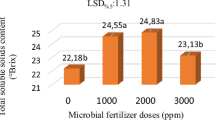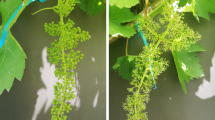Abstract
Foliar applications, which have been used in agriculture for many years, are one of the useful strategies to apply nutrients and chemicals directly to leaves and fruits for improving quality properties in various fruit species. In present study, the effectiveness of preharvest applications with benzoic acid (BA), citric acid (CA) and oxalic acid (OA) at three doses (0, 1000 and 1500 ppm) at two periods of berry growth, including berry setting period (P1) and verasion period (P2) on bioactive compounds and electrochemical response of cv. Horoz Karası were investigated in 2015 growing season. Study findings indicated that rising application doses of phenolic acids, including Benzoic Acid (BA), Oxalic Acid (OA) and Citric Acid (CA) at verasion period (P2) had considerable effects on table grape quality properties of cv. Horoz Karası than same doses of phenolic acids applications at berry setting period (P1). The highest increases in contents of total phenolic compounds, total anthocyanin and electrochemical characteristic were respectively encouraged by applications of BAP2 1500 ppm, BAP2 1000 ppm, OAP2 1500 ppm, OAP2 1000 ppm, CAP2 1500 ppm, CAP2 1000 ppm.






Similar content being viewed by others
References
Akay A, Kara Z (2006) P‑value and some other characteristics of tomato cultivar grown in greenhouse. Pak J Biol Sci 9(10):1991–1994
Cantin CM, Fidelibus MW, Crisosto CH (2007) Application of abscisic acid (ABA) at verasion advanced red color development and maintained postharvest quality of ‘Crimson Seedless’ grape. Postharvest Biol Technol 46:237–241
Cawthon DL, Morris JR (1983) Uneven ripening of ‘Concord’ grapes. Ark Farm Res 32:1–9
Chervin C, Aked J, Crisosto CH (2012) Grapes. In: Rees D, Farrel G, Orchard J (eds) Crop post-harvest: science and technology (perishables). Blackwell, West Sussex, UK, p 439. ISBN 978-0-632-05725-2
Coombe BG (1995) Adoption of a system for identifying grapevine growth stages. Aust J Grape Wine Res 1:104–110
Di Stefano R, Cravero MC (1991) Metodi per lo studio deipolifenolidell’uva. Riv Vitic Enol 2:37–45
Eibach R, Töpfer R (2015) Traditional grapevine breeding techniques. In: Reynolds AG (ed) Grapevine breeding programs for the wine industry. Elsevier, Cambridge, UK, p 427. ISBN 978-1-78242-080-4
El-Kobisy DS, Kady KA, Medani RA (2005) Response of pea plant Pisum sativum L. to treatment with ascorbic acid. Egypt J Appl Sci 20:36–50
Elmer PAG, Regliski T (2006) Biosuppression of Botrytis cinera in grapes. Plant Pathol 55:155–177
Ergun M (2012) Efficacy and inefficacy of refrigerated storages on some physical, physiochemical and electrochemical properties for organically-grown ‘Royal Glory’ and ‘Redhaven’ peaches. J App Bot Food Qual 85:79–85
Ergun M (2017) Physical, physiochemical and electrochemical responses of ‘Galaxy’ apples to mild bruising. Eur J Hortic Sci 82(5):244–250
Ergun M, Jezik KM (2011) Measuring electrochemical fruit quality of refrigerated ‘Hanita’ plum by Bioelectric Vincent Method. Zemdirbyste 98(3):315–322
Ezzat A, Ammar A, Zoltan S, Holb IJ (2017) Salicylic acid treatment saves quality and enhances antioxidant properties of apricot fruit. Hort Sci 44(2):73–81
Ferrara G, Mazzeo A, Matarrese AMS, Pacucci C, Pacifico A, Gambacorta G, Faccia M, Trani A, Gallo V, Cafagna I, Mastrorilli P (2013) Application of abscisic acid (S-ABA) to ‘Crimson Seedless’ grape berries in a Mediterranean Climate: effects on color, chemical characteristics, metabolic profile and S‑ABA concentration. J Plant Growth Regul 32:491–505
Ferrara G, Mazzeo A, Matarrese AMS, Pacucci C, Gallo V (2014) Effects of PGRs (GA3 and CPPU) and cane girdling on yield, quality and metabolic profile of cv. Italia table grape. Proceedings of the 7th International Table Grape Symposium,, Mildura, 12–14 November 2014, pp 74–75
Ford-Kapoor R (2010) Grape analysis in wine making. In: Butzke CE (ed) Winemaking problems solved. Woodhead, Cambridge, p 397. ISBN 978-1-4398-3416-9
Hayat Q, Hayat S, Irfan M, Ahmad A (2010) Effect of exogenous salicylic acid under changing environment: a review. Environ Exp Bot 68:14–25
Hoffmann M (1991) Elektrochemische Merkmale zur Differenzierung von Lebensmitteln. In: Meier-Ploeger A, Vogtmann H (eds) Lebensmittelqualität – Ganzheitliche Methoden und Konzepte – Alternative Konzepte, vol 66. CF Müller, Karlsruhe, pp 67–86
Kok D, Bal E (2016a) Variation in total phenolic compounds, anthocyanin and monoterpene content of ‘Muscat Hamburg’ table grape variety (V. vinifera L.) as affected by cluster thinning and early and late period basal leaf removal treatments. Erwerbs-Obstbau 58:241–246
Kok D, Bal E (2016b) Seedless berry growth and bioactive compounds of cv. ‘Recel Uzümü’ (V. vinifera L.) as Affected by Application Doses and Times of Pre-Harvest Thidiazuron. Erwerbs-Obstbau 58:253–258
Kok D, Bal E (2016c) Effects of foliar seaweed and humic acid treatments on monoterpene profile and biochemical properties of cv. Riesling (V. vinifera L.) throughout the maturation period. JOTAF 13(2):64–67
Kok D, Bal E (2017a) Assessment of electrochemical attribute and monoterpene content of twelve aromatic grape cultivars (V. vinifera L.) grown under the ecological conditions of northwestern Turkey. Oxi Commun 40(1–2):557–564
Kok D, Bal E (2017b) Electrochemical properties and biochemical composition of cv. Shiraz wine grape (V. vinifera L.) depending on various dose and application time of foliar microbial fertilizer treatments. Erwerbs-Obstbau 59:263–268
Kok D, Bal E (2018a) Leaf removal treatments combined with kaolin particle film technique from different directions of grapevine’s canopy affect the composition of phytochemicals of cv. Muscat Hamburg (V. vinifera L.). Erwerbs-Obstbau 60:39–45
Kok D, Bal E (2018b) Enhancing skin color and phenolic compounds of cv. Red Globe table grape (V. vinifera L.) utilizing of different preharvest treatments. Erwerbs-Obstbau 60:75–81
Kok D, Bal E, Celik S, Ozer C, Karauz A (2010) The influences of different seaweed doses on table quality of cv. Trakya Ilkeren (V. vinifera L.). Bulg J Agric Sci 16(4):429–435
Lantzouraki DZ, Sinanoglou VJ, Tsiaka T, Proestos C, Zoumpoulakis P (2015) Total phenolic content, antioxidant capacity and phytochemical profiling of grape and pomegranate wine. RSC Advan 5:101683–101692
Laszlo JC, Saayman D (1990) Optimum harvesting stage for Sultanina as table grape. Decid Fruit Grow 40:101–105
Mattivi F, Guzzon R, Vrhovsek U, Stefanini M, Velasco R (2006) Metabolite profiling of grape: flavonols and anthocyanins. J Agric Food Chem 54:7692–7702
Nelson KE (1979) Harvesting and handling california table grapes for market. ANR Publications, CA, USA, p 76. ISBN 0‑931876-33-8
Osrecak M, Karaoglan M, Kozina B (2016) Influence of leaf removal and reflective mulch on phenolic composition and antioxidant activity of Merlot, Teran and Plavac Mali wines (Vitis vinifera L.). Sci Hortic 209:261–269
Paulauskiene A, Danilcenko H, Jariene E, Gajewski M, Seroczynska A, Szymczak P, Korzeniewska A (2006) Quality of pumpkin fruits in relation to electrochemical and antioxidative properties. Veg Crop Res Bull 65:137–144
Ragab MM (2002) Effect of spraying urea, ascorbic acid and NAA on fruiting of Washington Navel orange trees. Faculty of Agriculture, Minia University Egypt, (M.Sc. Thesis), Minia, Egypt
Sandler HA, Brock PE, Vanden Heuvel JE (2009) Effect of three reflective mulches on yield and fruit composition of Coastal New England Wine grapes. Am J Enol Vitic 60:332–338
Shalini D, RajKumar R (2017) Exogenous foliar application of phenolic acids on quality constituents of tea. Int J Res Appl Sci Eng Technol 5(8):505–510
Shater Abd Allah MM, El-Bassiouny HMS, Elewa TAE, El-Sebai TN (2015) Effect of salicylic acid and benzoic acid on growth, yield and some biochemical aspects of guinoa plant grown in sandy soil. Int J Chemtech Res 8(12):216–225
Shimada M, Akamtsu Y, Tokimatsu T, Mii K, Hattori T (1997) Possible biochemical roles of oxalic acid as a low molecular weight compound involved in brown-rot and white-rot wood decays. J Biotechnol 53:103–113
Singleton VL, Timberlake CF, Kea L (1978) The phenolic cinnamates of white grapes and wine. J Sci Food Agric 29:403–410
Winkler AJ, Cook JA, Kliewer WM, Lider LA (1974) General viticulture. University of California Press, Berkeley, Los Angeles, p 713. ISBN 0‑520-02591-1
Wolf G, Rey C (1997) Wie Qualität elektrochemisch zu messen ist. In: Hoffmann M (ed) Vom Lebendigen in Lebensmitteln. Deukalion, Germany, pp 50–60
Zheng XL, Tian SP, Gidley MJ, Yue H, Li BQ (2007) Effects of exogenous oxalic acid on ripening and decay incidence in mango fruit during storage at room temperature. Postharvest Biol Technol 45:281–284
Author information
Authors and Affiliations
Corresponding author
Ethics declarations
Conflict of interest
D. Kok and E. Bal declare that they have no competing interests.
Rights and permissions
About this article
Cite this article
Kok, D., Bal, E. Changes on Bioactive Compounds and Electrochemical Characteristics of cv. Horoz Karası Table Grape (V. vinifera L.) Induced by Various Doses of Preharvest Applications of Benzoic Acid, Citric Acid and Oxalic Acid at Berry Setting and Verasion Periods. Erwerbs-Obstbau 61 (Suppl 1), 17–24 (2019). https://doi.org/10.1007/s10341-019-00443-3
Received:
Accepted:
Published:
Issue Date:
DOI: https://doi.org/10.1007/s10341-019-00443-3




